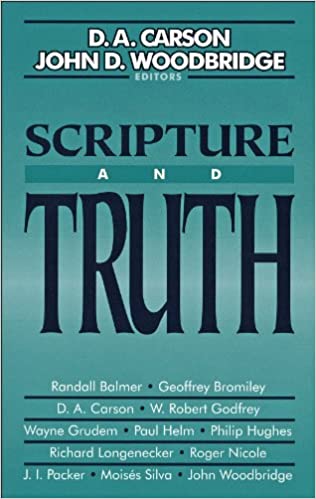A Brief Book Summary from Books At a Glance
By Steve West
Introduction
Scripture and Truth examines numerous biblical, historical, and theological issues concerning the relationship between God’s Word and truth. It consists of a collection of essays written by prominent evangelical scholars.
Table of Contents
Part 1 Biblical Essays
Chapter 1 Scripture’s Self-Attestation and the Problem of Formulating a Doctrine of Scripture
Wayne Grudem
Chapter 2 Unity and Diversity in the New Testament: The Possibility of Systematic Theology
D. A. Carson
Chapter 3 On the Form, Function, and Authority of the New Testament Letters
Richard N. Longenecker
Chapter 4 Redaction Criticism: On the Legitimacy and Illegitimacy of a Literary Tool
D. A. Carson
Chapter 5 The New Testament Use of the Old Testament: Text Form and Authority
Moises Silva
Part 2 Historical Essays
Chapter 6 The Truth of Scripture and the Problem of Historical Relativity
Philip Edgcumbe Hughes
Chapter 7 The Church Fathers and the Holy Scripture
Geoffrey W. Bromiley
Chapter 8 Biblical Authority in the Sixteenth and Seventeenth Centuries: A Question of Transition
W. Robert Godfrey
Chapter 9 The Princetonians and Biblical Authority: As Assessment of the Ernest Sandeen Proposal
John D. Woodbridge and Randall H. Balmer
Part 3 Theological Essays
Chapter 10 The Biblical Concept of Truth
Roger Nicole
Chapter 11 Faith, Evidence, and the Scriptures
Paul Helm
Chapter 12 Infallible Scripture and the Role of Hermeneutics
J. I. Packer
Summary
Chapter 1: Scripture’s Self-Attestation and the Problem of Formulating a Doctrine of Scripture
In order for believers to understand the nature of Scripture, we need to see what Scripture says about itself. The OT records instances of God speaking directly to people, and there is never a hint that human language is inadequate for accurate communication. Prophets delivered messages from God and spoke with his authority. The words the prophets used were God’s words, so the prophets sometimes spoke in the first person for God. Obeying or disobeying the words of the prophet was really obeying or disobeying God. God’s words were also put in writing, with no diminishment in authority.
The written word persisted through time, so it became the main source of revelation. The words of God were always true and pure. People were warned against adding to them or subtracting from them. Psalm 119 extols the many virtues and qualities of God’s words. Every word was to be treasured and obeyed. The NT writers accepted the OT as God’s Word. They held to the full trustworthiness and truth of even tiny details. God’s OT revelation was prophetic and authoritative, it was given for the edification of the church, and it pointed to Christ. The Holy Spirit continued to lead the apostles—as he had the prophets—to write God’s words for the new covenant era. Paul was aware he wrote the words of God, and the early church received certain writings as being on par with the OT.
The NT writings were just as much the word of God as the OT Scriptures. Absolute truthfulness is not the same as exact precision (i.e. the Bible can use round numbers, approximations, and figures of speech). God’s speech does not accommodate itself to people so far that it contains errors. Language is capable of communicating truth, and God does not communicate errors or lies. Every word in the Bible is God’s word, and so it is authoritative and truthful. We should hold that the Bible is verbally inspired and infallible in all of its words. It is true, powerful, holy, and life-transforming.
Chapter 2: Unity and Diversity in the New Testament: The Possibility of Systematic Theology
Many scholars believe that the NT is filled with contradictions, and that it contains a welter of competing and inconsistent theologies. When the unity of thought in the NT is denied, systematic theology is ruled out. Systematic theology examines what the Scriptures say, taking the Bible as a completed whole, and demonstrating logical connections in the material. If the NT is unified and coherent—while recognizing its diversity—then the formulations of systematic theology can be biblical and valuable. J. D. G. Dunn follows in the stream of Walter Bauer’s critical approach to the NT, which posited inconsistencies and a lack of unity. Dunn focuses on the diversity of the NT, and only allows for a lowest common denominator of theological unity. Unfortunately, despite some admirable qualities, Dunn’s work is selective in its use of the data and evidence, and he also makes some mistakes in interpretation. He finds inconsistency (e.g. in Christology) where there is really complementarity.
[To continue reading this summary, please see below....]The remainder of this article is premium content. Become a member to continue reading.
Already have an account? Sign In
